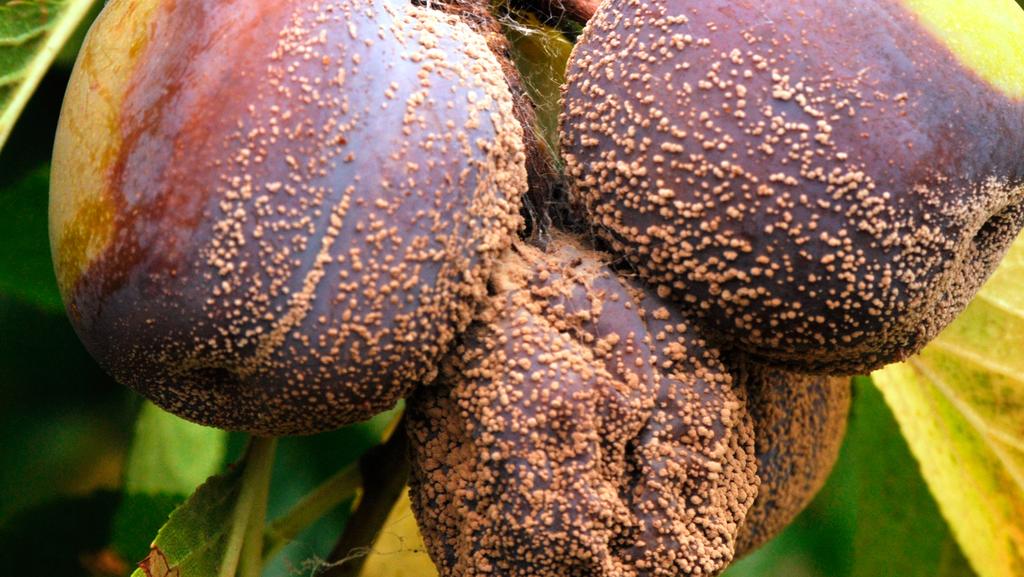Plums, peaches, nectarines and apricots come under attack every summer — always as fruit nears maturity or begins to ripen.
It first starts as one or two small brown spots on the skins which then spread widely, causing the fruit to rot while still hanging.
Then masses of buff-coloured or pale grey pustules form as the fruit either drops to the ground or, more often, shrivels and remains clinging to twigs, gradually becoming mummified.
If not removed, these shrunk, dried fruit clusters remain stuck to branches right through winter.
They are brimming with overwintering brown rot disease organisms and are the main means by which the disease continues to strike, year after year.
Dormant fungal organisms also pass through winter on twiggy growth that has carried diseased fruit.
Infected wood is easily identified because it looks dead while oozing tiny blobs of hardened sap.
Spraying to help counter brown rot is a waste of time and money right now, so don’t bother — there are safer means of control.
While the ultimate target of this fungal disease is fruit, it’s important to bear in mind it is primarily the trees and blossoms that are first attacked in spring. We hardly notice in late winter and spring when some blossoms shrivel and turn black and some younger shoots begin to ooze sap.
This is the first stage of brown rot and the disease then passes through summer to emerge again as the fruit ripens, starting the process again.
The only way to obtain good control of brown rot is by a combination of strict hygiene and careful pruning.
Every bit of diseased fruit littering the ground beneath trees must be raked up and taken away.
I go further and hard-mow all grass beneath infected trees, even scalping the surface and always with a grass-catcher attached.
Then the shaven ground should be raked to dislodge any fruit embedded in the soil.
The trees should then be pruned, first to remove all clinging mummies and rotting fruit clusters.
Then cut out all diseased twiggy shoots. It is this young, fruit-bearing growth that is most vulnerable to infection.
Have a wheelbarrow parked nearby so every bit of diseased debris is instantly collected.

Where trees have been seriously attacked, a large amount of diseased material will need to be removed and then taken well away or burned. It must never be composted.
Spreading lime around and beneath stone fruit trees is normal at this time of year.
The fine, white builders’ lime is best because it is cheap and sweetens the soil twice as fast as ground limestone.
Lime has another advantage. It not only speeds up the rate of decomposition of any diseased material, but earthworms love the stuff.
They multiply rapidly in well-limed soil and get to work devouring and processing decomposing organic matter, converting even diseased debris into wormcasts, a safe, nutrient-rich fertiliser.
After this treatment, fruit trees should be given a long, deep watering to encourage fresh, healthy growth.
The soil is still warm and there are many good growing weeks ahead, allowing most stone fruit trees to produce enough fruiting wood for next summer’s crops.
Keep an eye on the trees during winter, cutting out any mummified fruit, plus the branches to which it is attached.
In late winter, before the leaves appear, spray with a copper-based fungicide such as Bordeaux. This gives limited control, but is nowhere near as effective as hygiene, pruning and the removal of all disease-laden debris.
In spring, examine blossoms as they fade and ruthlessly prune out all flowering wood carrying flowers that have turned black and remain stuck to branches.
-----------------------------------------------------------------------
Check out our Tasmanian Planting Calendar Fridge Magnet – A5 size only $19

A year-round guide for when to plant your veggies in Tasmania. Never lose your planting guide again with a convenient fridge magnet for secure attachment to any metal surface. This growing guide has been tried and tested by some of the best Gardener’s in Tasmania, and is specifically adapted to the Tasmanian climate.
Excellent Gift for any Tasmanian you know with green thumbs and who likes Peter Cundall as much as i do!
Make sure you follow the calendar and you will have a successful year of growing vegetables in Tasmania.
Price includes FREE SHIPPING Australia wide. BUY HERE